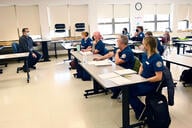You have /5 articles left.
Sign up for a free account or log in.
A growing body of research shows that college students who enroll full-time, taking even 12 credits’ worth of course work in a single semester, are much more likely stick with college, save money and eventually graduate.
Yet while the researchers behind these studies encourage efforts to nudge more students to go full-time (ideally taking 30 credits in a year), they warn against neglecting the many who will continue to attend part-time because of work and family demands -- currently only 38 percent of community college students are enrolled full-time, according to the American Association of Community Colleges.
In addition, they said colleges and policy makers should avoid full-time enrollment incentives that veer toward the punitive. Some critics have made that charge about the 30-credit provision in New York State’s new free-college plan, which means students will be on the hook to pay back the tuition costs of their second semester if they fall even a credit short in a year.
The latest evidence of the benefits of full-time enrollment status comes in a newly released report from the Center for Community College Student Engagement at the University of Texas at Austin.
By looking at transcript data of 17,085 students from 28 community colleges, the center found that 34 percent of students who went full-time for at least some time earned an associate degree or a certificate, compared to only 23 percent who enrolled part-time throughout their community college experience.
Full-time enrollment in the first term also led to a substantial graduation rate bump, according to the study, which tracked students from 2005 to 2013.
Students who took at least 12 credits when they first arrived at college were more likely to return for a second year (77 percent compared to 64 percent) and to earn a credential (38 percent compared to 31 percent).
“Because there is an obvious benefit in students having some full-time experience, a full-time edge, you might say, colleges should consider asking each student one straightforward question: Is there any way you could attend full-time, even for one semester?” Evelyn Waiwaiole, the center’s executive director, said in a written statement.
The new report builds on previous research from the Center for Community College Research at Columbia University’s Teachers College.
Last year CCRC released a study looking at the comparative benefits of students who took even larger course loads -- at least 15 credits -- during their first semester of enrollment at public institutions in Tennessee, both at two-year colleges and four-year institutions.
Community college students who took at least 15 credits were 6.4 percentage points more likely to earn a credential than those who took 12, the study found. That gap was 11 percentage points among students at four-year institutions.
The findings from the two studies in some ways fly in the face of conventional wisdom, which holds that less prepared and first-generation students, including those from minority groups or low-income backgrounds, should ease their way into college with relatively light course loads.
“That turns out to be very bad advice,” said Davis Jenkins, a senior research associate at CCRC and co-author of the Tennessee study. “It’s the soft bigotry of low expectations. … We’re not being straight with students.”
Don’t Forget Part-Timers
In general, full-time students are much more likely to graduate than their part-time peers, as community colleges have long known. Yet the substantial benefits of any experience as a full-time student might surprise some.
The Center for Community College Student Engagement report describes several reasons why this might be happening.
One is that students who initially take a full load are more likely to be required to go through a new-student orientation. And full-time students spend more time on campus and have better access to support services, including academic advisers. Just as important, they have more opportunities to collaborate with other students and to be exposed to full-time faculty members.
For example, 30 percent of students who attended part-time throughout community college reported that they never talked about career plans with an instructor or adviser, according to a center survey, compared to 19 percent of always full-time students and 22 percent of students with fluid attendance patterns.
“They get early engagement. They’re not just getting engagement in that last semester,” Waiwaiole said in an interview. She adds that full-time students are “just more knowledgeable about the experience of how to get through college.”
Both Waiwaiole and Jenkins said they hope research on the benefits of full-time attendance will help colleges to adjust how they operate. That means tweaking schedules to make it possible for working students to take more courses. And for students who do go all in with a full-time load, they said colleges need to do more up front to help them set a plan to get to graduation.
“We really have to change educators’ mind-sets,” said Jenkins.
Complete College America is a nonprofit organization that is pushing hard on full-time enrollment with a campaign dubbed 15 to Finish. The group’s president, Tom Sugar, applauded the new report from CCCSE, pointing to “tragic” graduation rates for part-time students.
“Fifteen credits work better for students across the board,” said Sugar.
The group, which receives funding from the Bill & Melinda Gates Foundation, points to several states and institutions that are seeking to make a 15-credit load more appealing to students. Minnesota and Indiana make additional state-based grant aid available for students who go full-time, Sugar said. And the Indiana University System charges the same tuition rate for 15 credits as it does 12 credits -- so-called “banded” tuition rates.
Even so, part-time students will remain a large group in American higher education, at least for the foreseeable future.
Only half of the four-year college students in CCRC’s Tennessee study sample attempted to take 27 or more credits in their first year. And just 28 percent of the state’s two-year college students took at least 15 credits in their first semester, the study found, with that number dropping to 20 percent for a full year.
“We need to help our colleges find ways to better design their services to help part-time students,” said Karen Stout, president and CEO of Achieving the Dream, a nonprofit group that works on college completion in the two-year sector.
While Jenkins said he supports efforts to encourage more students to take 30 credits in a year, it’s important to recognize that this is far from an easy lift.
“Students who have limited means, it can be difficult for them,” he said, particularly as many work for 30 or more hours a week.
In addition, Jenkins said research shows that the retention and completion benefits of taking a full load is about attempting the courses, not necessarily passing all of them. Community college students tend to fail 15 to 20 percent of their courses, he said.
New York left little margin for error in its free-college plan’s 30-credit requirement, likely by design. And participating students who fail courses might be surprised to receive a tuition bill.
“There’s good intention with this. And it builds on the momentum about access,” Stout said of New York’s legislation. But she adds that “it’s going to shut a lot of people out.”
Stout said tough questions remain about who can go to college full-time, and called for a nuanced approach to policies that seek to move more students in that direction.
“Is privilege behind the full-time edge?” she said.




